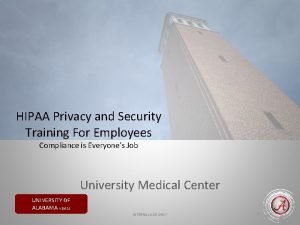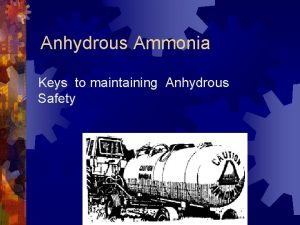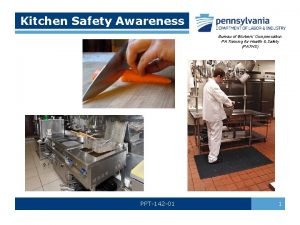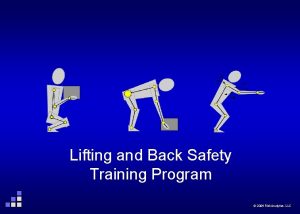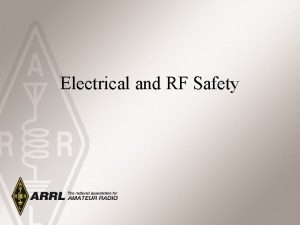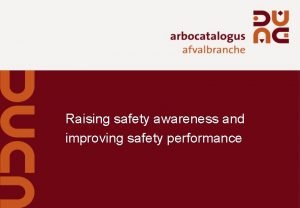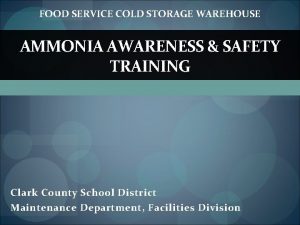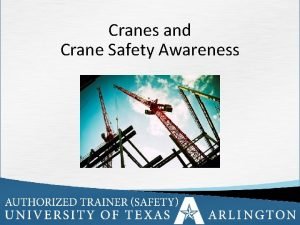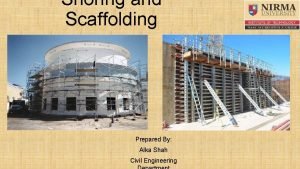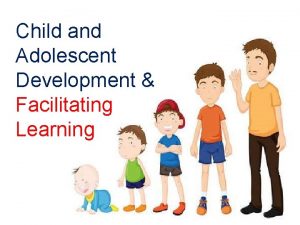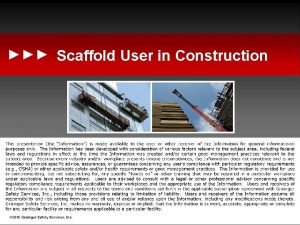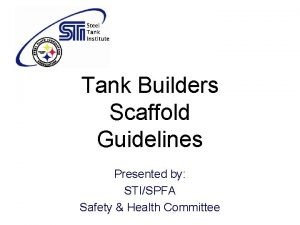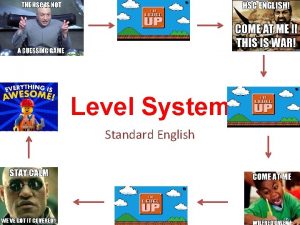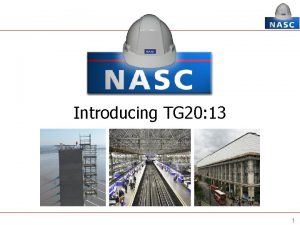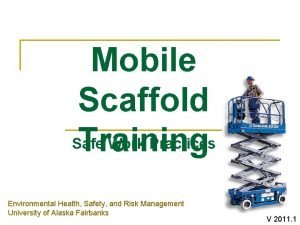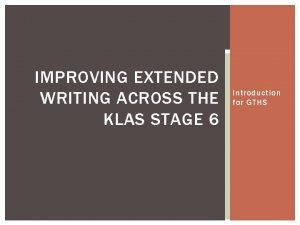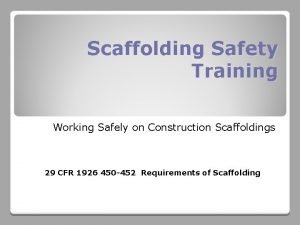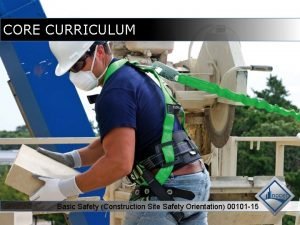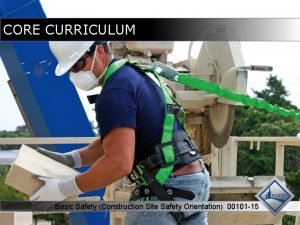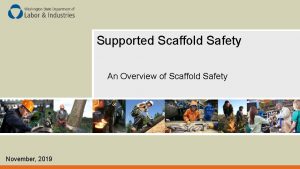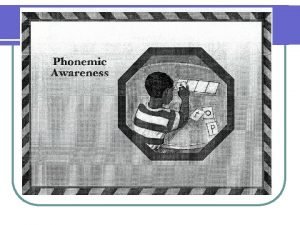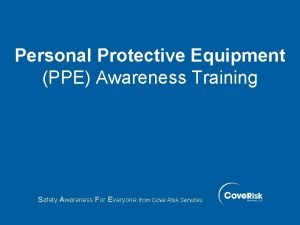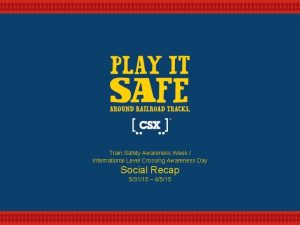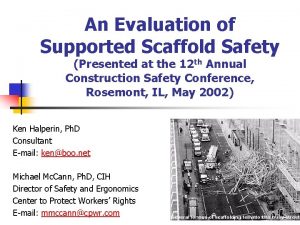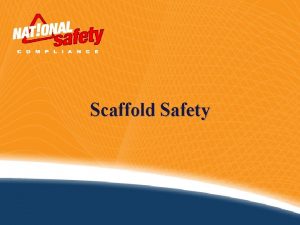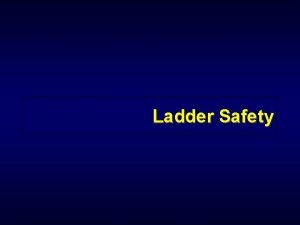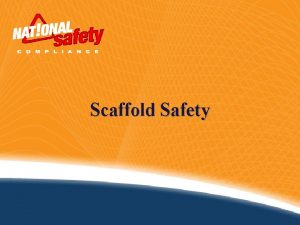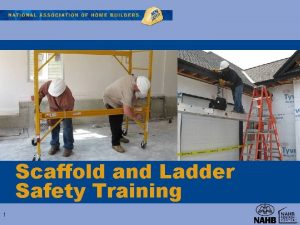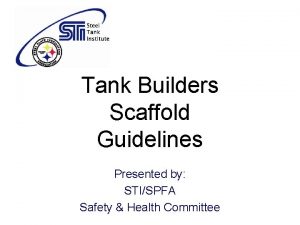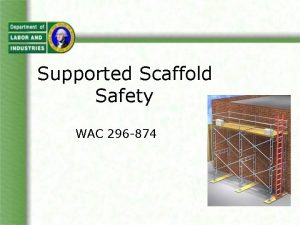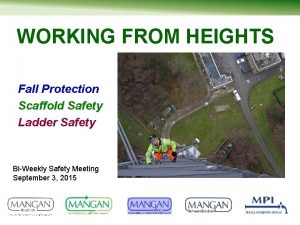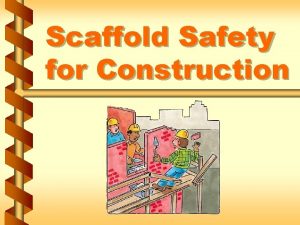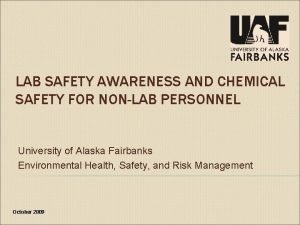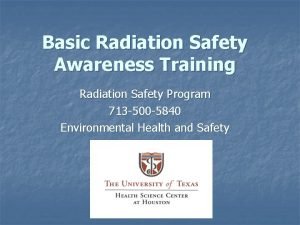Scaffold Safety Awareness 1 What Is A Scaffold




































- Slides: 36

Scaffold Safety Awareness 1

What Is A Scaffold? An elevated, temporary work platform Three basic types: Ø Supported scaffolds -- platforms supported by rigid, load bearing members, such as poles, legs, frames, & outriggers Ø Suspended scaffolds -- platforms suspended by ropes or other non-rigid, overhead support Ø Aerial Lifts -- such as “cherry pickers” or “boom trucks” 2

Hazards Employees working on scaffolds are exposed to these hazards: • Falls from elevation – caused by slipping, unsafe access, and the lack of fall protection • Struck by falling tools / debris • Electrocution – from overhead power lines • Scaffold collapse - caused by instability or overloading • Bad planking giving way 3

Fall Hazards Falls may occur: While climbing on or off the scaffold Working on unguarded scaffold platforms When scaffold platforms or planks fail 4

Protecting Workers from Falls If a worker on a scaffold can fall more than 10 feet, protect them by: Guardrails, and/or Personal Fall Arrest Systems (PFAS) 5

Guardrails Install along open sides & ends Front edge of platforms not more than 12 inches from the work, unless using guardrails and/or PFAS Top rails - 36 to 43 inches tall Midrails halfway between toprail and platform Toeboards at least 3 -1/2 inches high 6

Personal Fall Arrest Systems (PFAS) You must be trained how to properly use PFAS include anchorage, lifeline and body harness. 7

Fall Protection Requirements l l l Can use PFAS instead of guardrails on some scaffolds, must be tagged advising PFAS requirements. Use PFAS & guardrails on suspension scaffolds Use PFAS on erectors and dismantlers of scaffold systems. The ends of this scaffold are not properly guarded 8

Falling Object Protection l l Wear hardhats Barricade area below scaffold to forbid entry into that area Use panels or screens if material is stacked higher than the toeboard Build a canopy or erect a net below the scaffold that will contain or deflect falling objects 9

Overhead Power Lines The possibility of electrocution is a serious consideration when working near overhead power lines Check the clearance distances listed in the standard 10

Scaffold Support Examples Base plate Mud sills Good support Inadequate support – in danger of collapse? 11

Essential Elements of Safe Scaffold Construction • Use appropriate scaffold construction methods • Proper scaffold access • Properly use a competent person 12

Scaffold Platform Construction Platforms must: • be fully planked or decked with no more than 1 inch gaps • be able to support its weight & 4 times maximum load • be at least 18 inches wide This is not a properly constructed scaffold 13

Scaffold Platform Construction • No large gaps in front edge of platforms • Each abutted end of plank must rest on a separate support surface • Overlap platforms at least 12 inches over supports, unless restrained to prevent movement Planks not properly overlapped 14

Scaffold Platform Construction • • • No paint on wood platforms Use scaffold grade wood Fully planked between front upright and guardrail support • Component pieces used must match and be of the same type • • Erect on stable and level ground Lock wheels and braces 15

Scaffold Height The height of the scaffold should not be more than three times the least lateral dimension unless guys, ties, or braces are used 16

Scaffold Engineering Requirements Frame scaffolds over 15 metres (50 feet) in height Must be designed by a Professional Engineer

Scaffold Engineering Requirements Tube & Clamp and System scaffolds over 10 metres (33 feet) in height must be designed by a Professional Engineer

Platform Ends Each end of a platform, unless cleated or otherwise restrained by hooks, must extend over its support by at least 6 inches No Cleats 19

Supported Scaffolds Platforms supported by legs, outrigger beams, brackets, poles, uprights, posts, & frames Restrain from tipping by guys, ties, or braces Scaffold poles, legs, posts, frames, and uprights must be on base plates and mud sills or other firm foundation This support is not adequate! 20

Proper Scaffold Access Provide access when scaffold platforms are more than 2 feet above or below a point of access Permitted types of access: Ladders, such as portable, hook-on, attachable, stairway type, and built-ins Stair towers Ramps and walkways May use building stairs and come out window 21

Scaffold Access • No access by crossbraces • When using ladders, bottom rung no more than 24 inches high • Can use some end frames • Can access from another scaffold, structure or hoist End Frame Do not access by crossbraces 22

Suspension Scaffolds Platforms suspended by ropes or wires. Rope must be capable of supporting 6 times the load Train employees to recognize hazards Secure/tie to prevent swaying Support devices must rest on surfaces that can support four times the load Competent person: Ø evaluate connections to ensure the supporting surfaces can support load Ø inspect ropes for defects before shift PFAS must have anchors independent of the scaffold support system 23

Moving Scaffolds Employees can’t be on a moving scaffold unless: • Surface is level • A PFAS is used and attached to a fixed support • Outriggers are installed on both sides of scaffolds Employees can’t be on scaffold part beyond the wheels Competent person must be on site to supervise 24

Fatal Fact – Moving a Lift Employee was operating an aerial lift, with an extendable boom rotating work platform The boom was fully extended and the machine apparently ran over some bricks, causing the boom to flex or spring, throwing the employee from the basket The employee fell 37 feet to a concrete surface 25

Don’t use Shore or Lean-to Scaffolds Shore scaffold supported scaffold which is placed against a building or structure and held in place with props Lean-to scaffold supported scaffold which is kept erect by tilting it toward and resting it against a building or structure 26

Using Scaffolds Don’t work on snow or ice covered platforms during storms or high winds Use tag lines on swinging loads Protect suspension ropes from heat & acid A covered scaffold has special wind load considerations 27

Fatal Fact – Ice & No Guardrails Laborer was working on the third level of a tubular welded frame scaffold which was covered with ice and snow The scaffold was not fully decked, there was no guardrail and no access ladder The worker slipped and fell head first 20 feet to the pavement below 28

Overhand Bricklaying from Supported Scaffolds A guardrail or personal fall arrest system is required on all sides except the side where the work is being done 29

Competent Person capable of identifying and promptly correcting hazards Determines if it’s safe to work on a scaffold during storms or high winds Trains workers to recognize hazards Selects qualified workers to conduct work 30

Scaffold Inspection Competent person inspects scaffolds for visible defects before each shift and after any alterations Defective parts must be immediately repaired Deformed bearer 31

Scaffold Erection Scaffolds can only be erected, moved, dismantled or altered under the supervision of a competent person Competent person selects & directs these workers and determines the feasibility of fall protection 32

Training Requirements Train employees on scaffold hazards and procedures to control the hazards The training must include: • Nature of electrical, fall, and falling object hazards • How to deal with electrical hazards and fall protection systems • Proper use of the scaffold • Scaffold load capacities Retrain as necessary 33

Training Erectors Train employees involved in erecting, disassembling, moving, operating, repairing, maintaining, or inspecting a scaffold to recognize its hazards and the correct procedures to use 34

Avoid the Main Hazards of Scaffolds Falls from elevation Bad planking Scaffold collapse Improper loading or overloading Climbing up or down scaffolds Getting struck by falling tools or debris Electrocution Platforms without guardrails Moving scaffold with workers on the platform 35

Summary Remember to: Use appropriate scaffold construction methods Erect, move, or alter scaffold properly Protect from falling objects or tools Ensure stable access Use a competent person Train on scaffold construction and the hazards involved with scaffolds Inspect scaffold before each shift and after alterations Determine fall protection requirements 36
 Cvs privacy awareness training answers
Cvs privacy awareness training answers Ammonia awareness safety policy
Ammonia awareness safety policy Kitchen safety awareness
Kitchen safety awareness Back safety training
Back safety training Rf safety awareness training answers
Rf safety awareness training answers Raising safety awareness
Raising safety awareness Cold storage
Cold storage Crane swing radius barricade
Crane swing radius barricade 13 malaysian patient safety goals
13 malaysian patient safety goals Independent scaffold diagram
Independent scaffold diagram Patented scaffolding images
Patented scaffolding images Child and adolescent development and facilitating learning
Child and adolescent development and facilitating learning Scaffold terminology
Scaffold terminology Scaffolding support in tank
Scaffolding support in tank Petal scaffold
Petal scaffold Tg 20
Tg 20 Mobile scaffolding hazards
Mobile scaffolding hazards Burl and paul have a total weight of 1300 n
Burl and paul have a total weight of 1300 n Business report format hsc
Business report format hsc Each platform must be fully planked
Each platform must be fully planked Txxxc structure
Txxxc structure Scaffold plank overhang
Scaffold plank overhang Bioresorbable vascular scaffold
Bioresorbable vascular scaffold Pump jack scaffold must be fitted with two
Pump jack scaffold must be fitted with two Profase
Profase Why does dimmesdale go to the scaffold
Why does dimmesdale go to the scaffold Statue of liberty scaffold
Statue of liberty scaffold Drupal 8 composer
Drupal 8 composer Fall protection competent person training ppt
Fall protection competent person training ppt Fascia and gutter scaffold
Fascia and gutter scaffold A brick falls freely from a high scaffold
A brick falls freely from a high scaffold Feature article scaffold
Feature article scaffold Safety assessment for ind safety reporting
Safety assessment for ind safety reporting Four shades function for the encs
Four shades function for the encs 00101-15 basic safety
00101-15 basic safety Qbs safety care
Qbs safety care Basic safety orientation
Basic safety orientation
